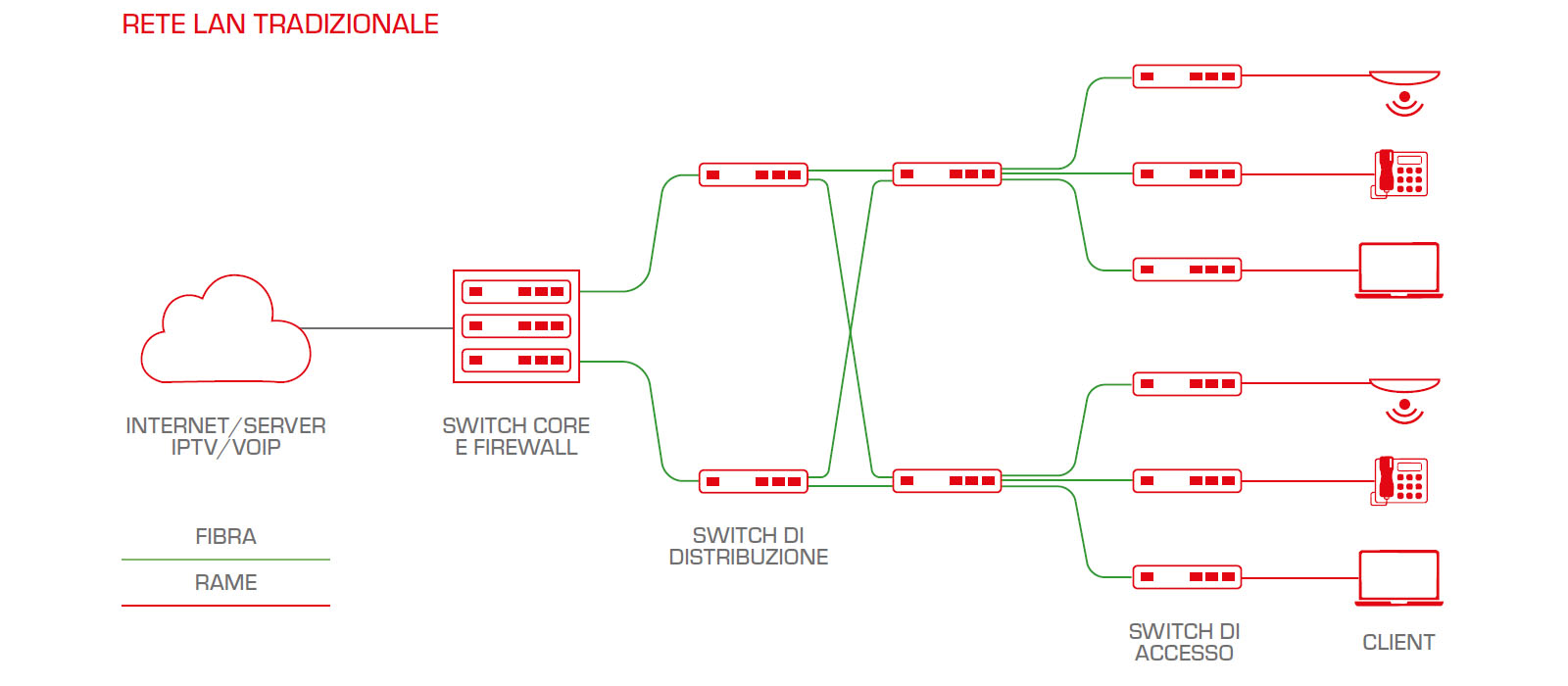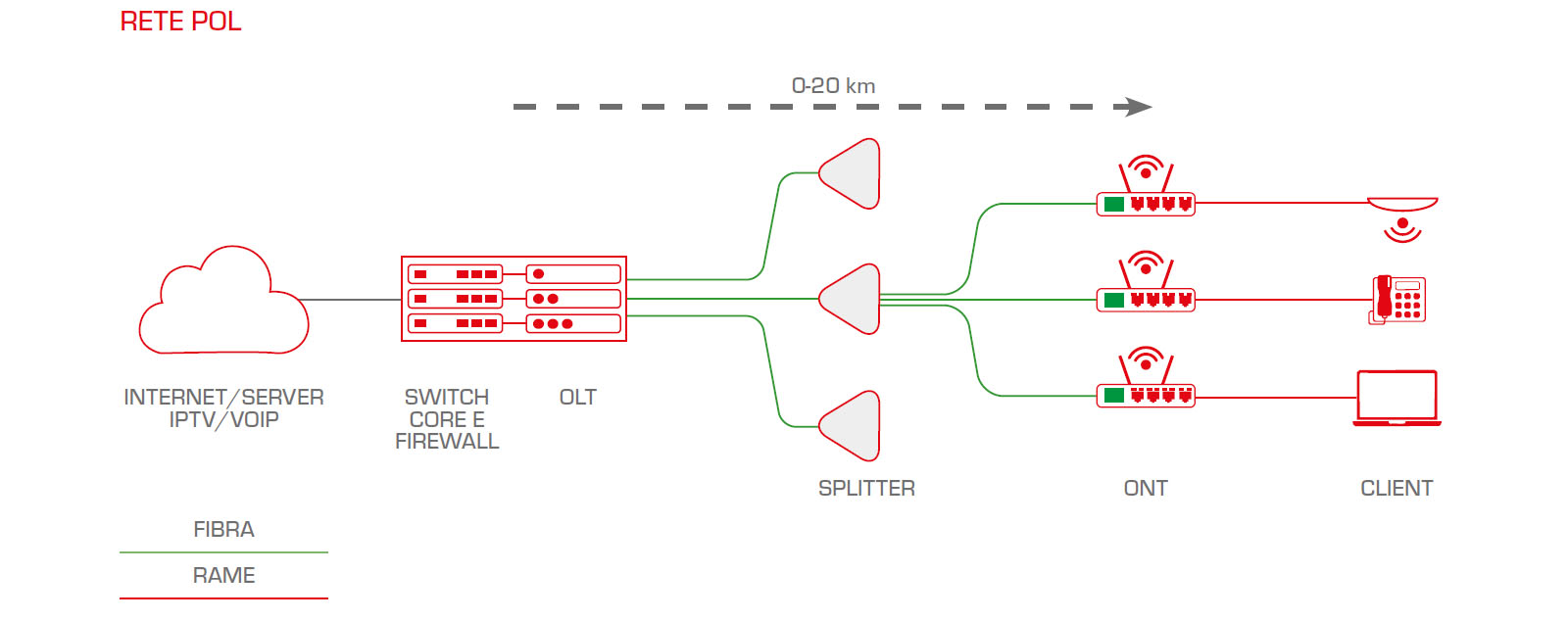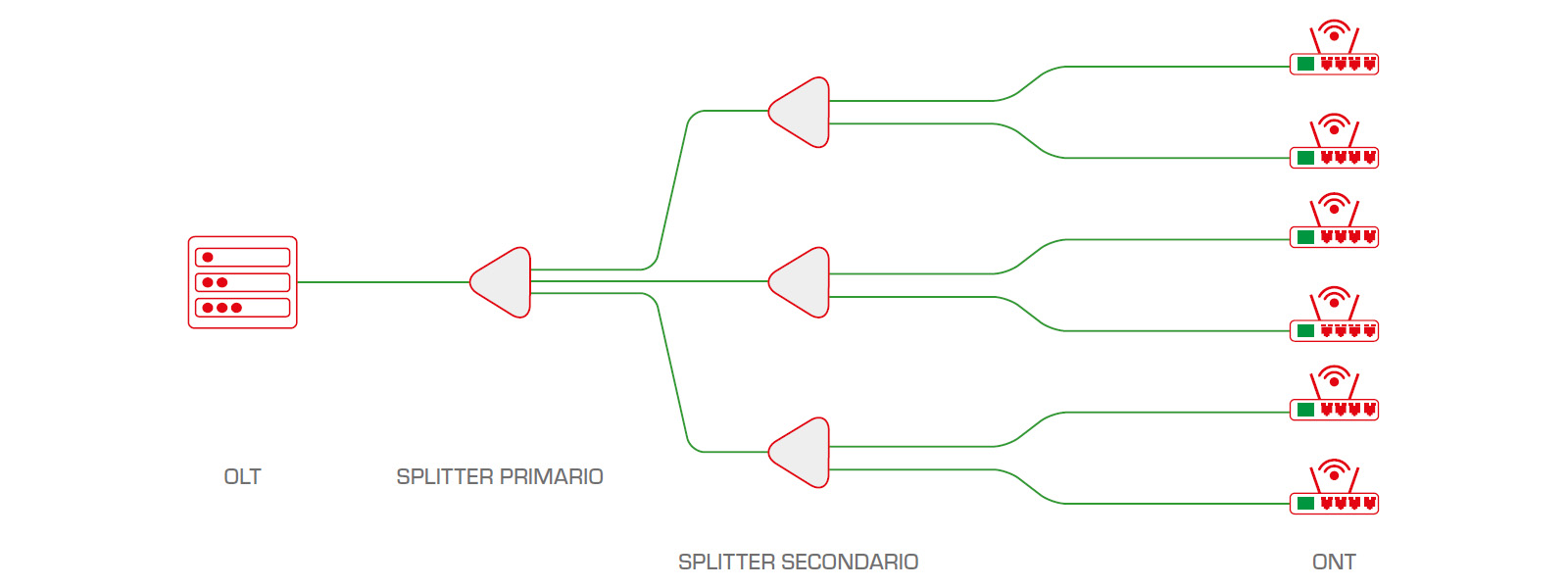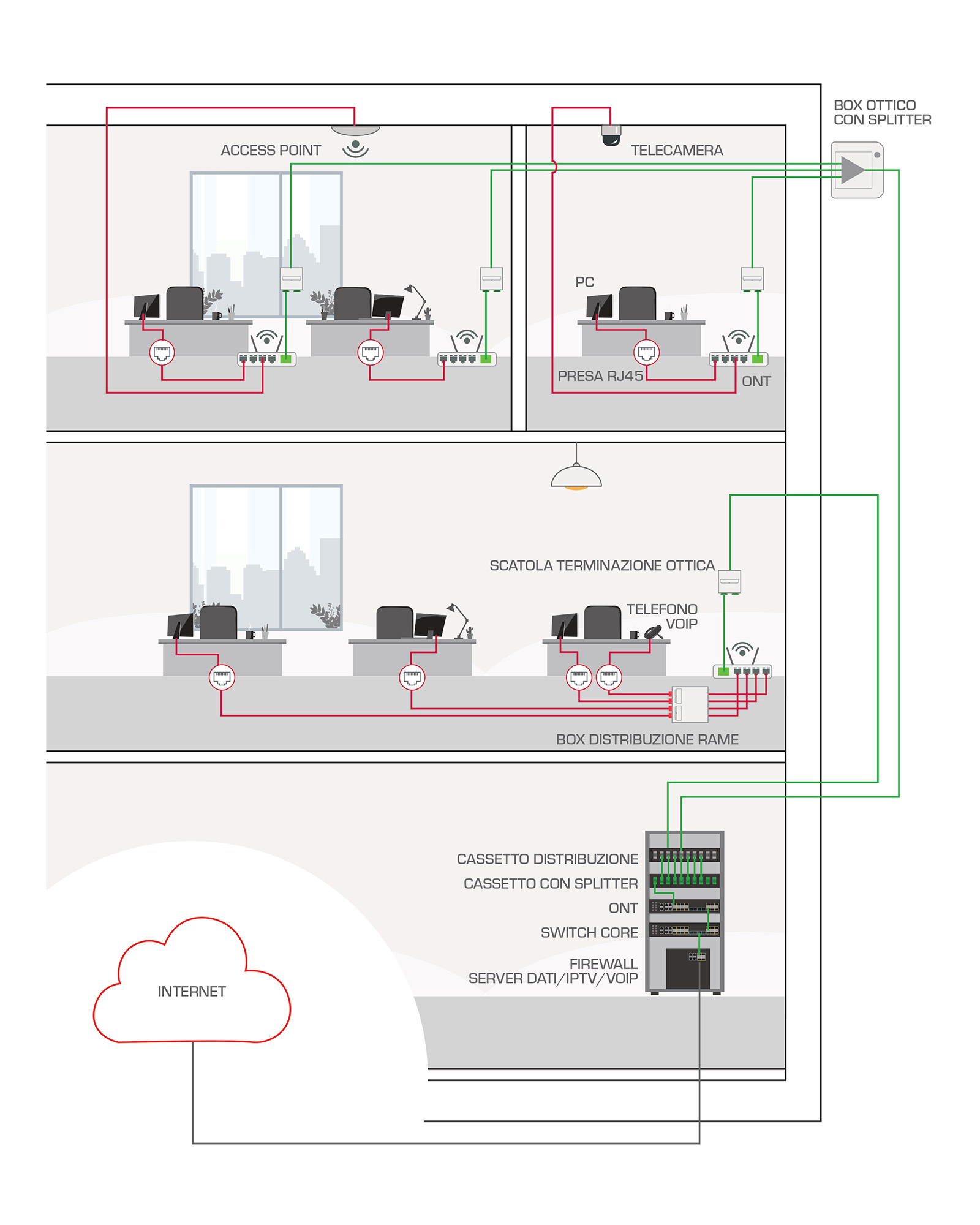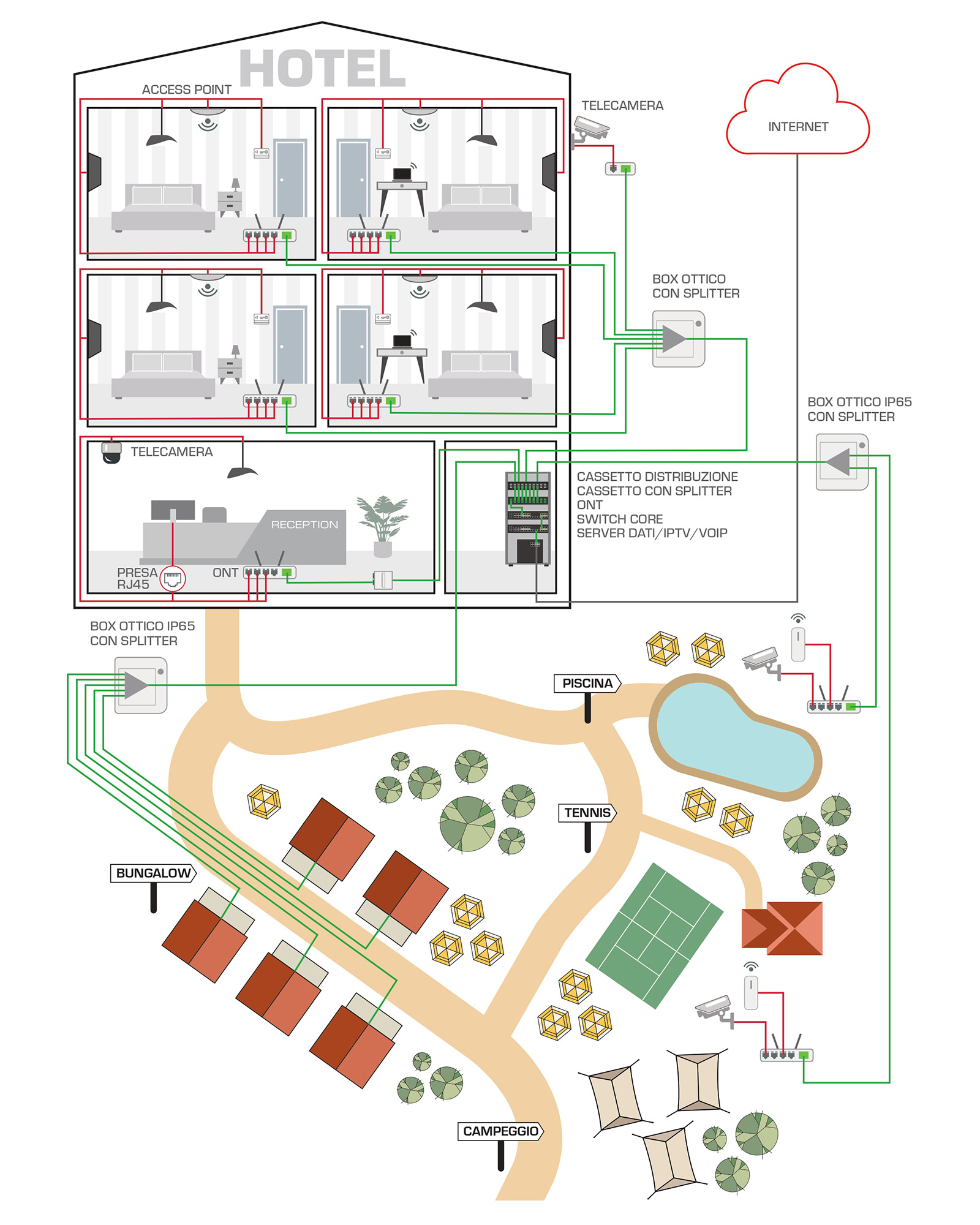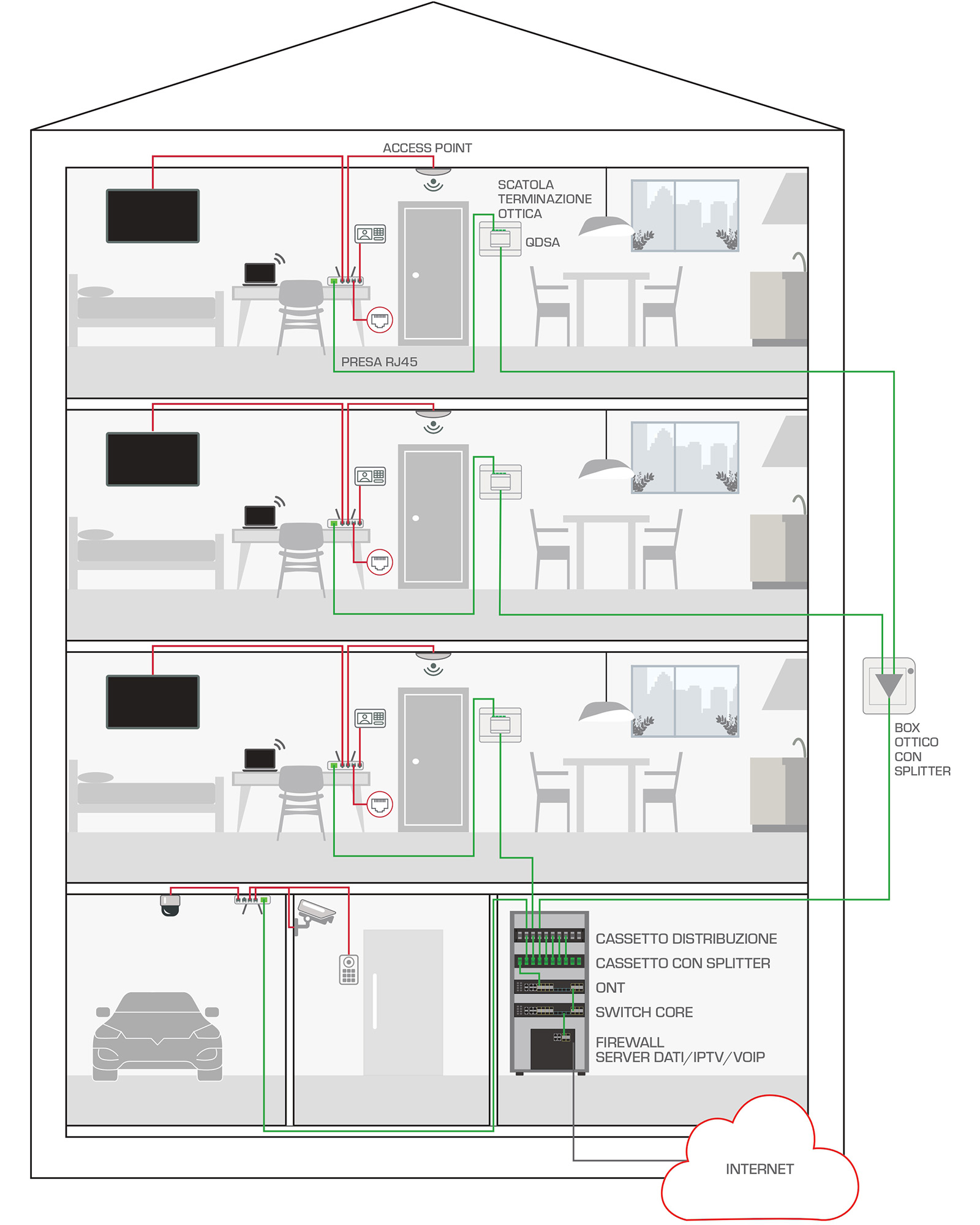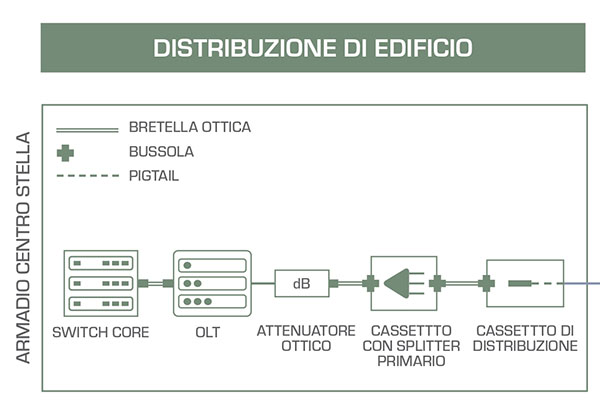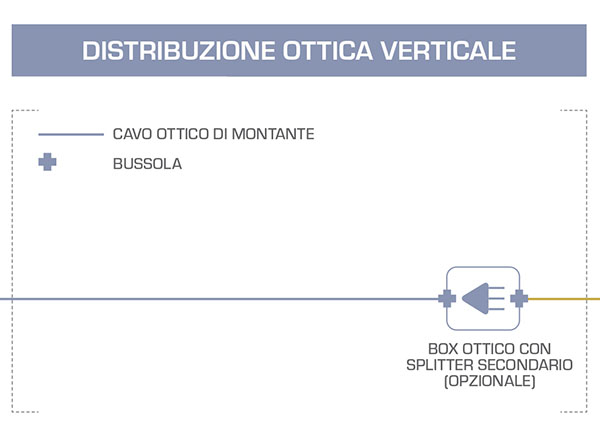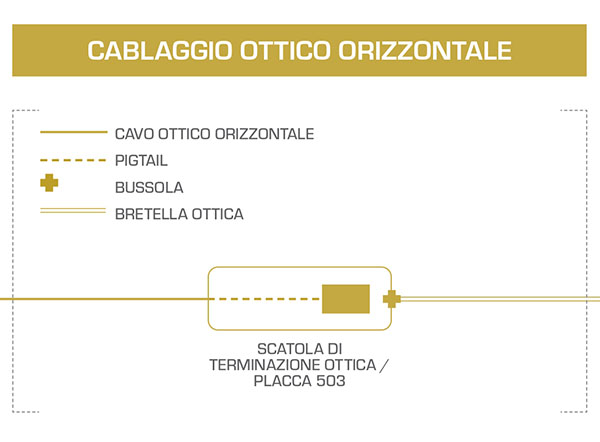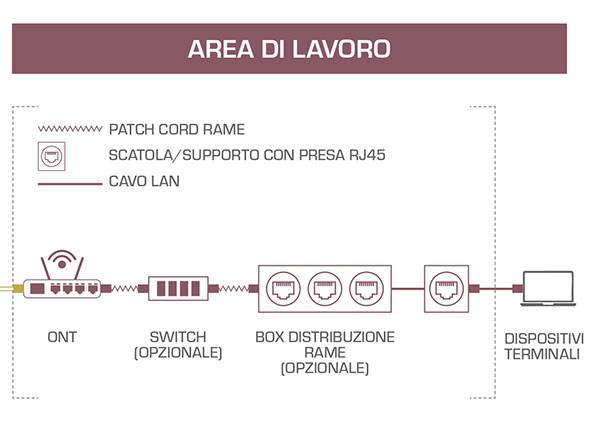POL/GPON networks introduction
What is POL/GPON network?
POLAN or POL are the acronyms used to identify the best-known PON (Passive Optical Network) networks when this type of structure is applied to the realization of business and enterprise LANs in which extension and number of users are more limited.
Structurally identical to PON but with a maximum extension of 20 km, the POL network supports multiple services and is characterized by a limited number of components, reduced infrastructure size, simple installation and high bandwidth.
This network type is totally passive deploying fibre optic cables and splitters to directly connect the users to the main node of the network through a point-multipoint design, with a single optical fibre shared with multiple users, providing high quality services and high bandwidth.
Active equipments are positioned only upstream and downstream of the network and through optical modules exploiting WDM (Wavelength Division Multiplexing) technology, allow two-way communication on a single fibre.
Fibre optic POL networks grant clear advantages compared to traditional copper networks: higher bandwidth and longer distance of access, lower energy consumption, higher reliability and durability.
Thanks to the ongoing evolution of the devices and optical transmitters, a POL network is fully scalable, safe and future proof with a lower Total Cost of Ownership.
Traditional LAN vs POL
A LAN (Local Area Network) is a hierarchical star topology network covering a small geographic area such as an office, school or building. It deploys mostly copper cables in Cat 6 or Cat 6A to connect all the terminal devices to the switches located inside the rack cabinets. Fibre optics are used only to connect the racks together. Network management is centralized with administrators configuring and monitoring devices and connections.
A POL network (Passive Optical LAN) uses mostly fibre optics to provide connectivity. It deploys a point-multipoint topology with a single optical fibre cable from an OLT (Optical Line Terminal) that branches out to different ONTs (Optical Network Terminal) through passive splitters. The use of copper cables is reduced and limited to the terminal connection of the devices to the ONTs. Network management is centralized and the maintenance is simplified thanks to the reduction of the active components and the higher reliability of fibre optics.
POL/GPON network components
Optical Line Terminal (OLT)
![]() The OLT (Optical Line Terminal) is the electrically powered active device positioned upstream of the link working as central processing unit and is connected from one side to the network switches for connection to the local network services and internet, to the other side to the ONT (Optical Network Termination) through the fibre network.
The OLT (Optical Line Terminal) is the electrically powered active device positioned upstream of the link working as central processing unit and is connected from one side to the network switches for connection to the local network services and internet, to the other side to the ONT (Optical Network Termination) through the fibre network.
The OLT typically has LAN copper or SFP ports used as uplinks to the network switches and PON ports to connect to the remote devices. Each PON port theoretically can serve up to 128 ONTs but in practice this number should be calculated based on the characteristics of the network, the optical attenuation and the available power budget.
Optical Splitter
![]() One of the main components of a POL network is the optical splitter. It splits the optical signal from the OLT into more outputs switching from typical P2P network to a P2MP topology without reducing the available bandwidth.
One of the main components of a POL network is the optical splitter. It splits the optical signal from the OLT into more outputs switching from typical P2P network to a P2MP topology without reducing the available bandwidth.
Splitters have a splitting ratio of 1xN up to 1:128 or 2xN type for the deployment of redundant networks.
Optical Network Terminal (ONT)
![]() The ONT (Optical Network Terminal) is an active device positioned downstream of the fibre link acting as the termination point of the POL network. It converts the optical signal into electrical signals and vice versa. It features an optical port for the connection to the OLT and one or more LAN copper ports and possible wireless connectivity for access to network services for connected clients.
The ONT (Optical Network Terminal) is an active device positioned downstream of the fibre link acting as the termination point of the POL network. It converts the optical signal into electrical signals and vice versa. It features an optical port for the connection to the OLT and one or more LAN copper ports and possible wireless connectivity for access to network services for connected clients.
Downstream of the ONT there can be a network switch to further extend the number of available links or to power any remote devices in PoE.
Optical Cable
![]() For the realisation of the POL infrastructure single-mode fibre cables are used, preferably of the bending loss insensitive G.657.A2 type.
For the realisation of the POL infrastructure single-mode fibre cables are used, preferably of the bending loss insensitive G.657.A2 type.
For indoor or outdoor backbone sections, paths are straighter and the bending radii do not cause attenuations such as to justify the use of specific fibres. In this case optical fibres of G.652.D type can be used.
POL network advantages
REDUCTION OF SPACES DEDICATED TO CABLING
In copper LAN networks, to respect the distance limits set by the applications, it is necessary to position intermediate concentrator cabinets for which suitable space or dedicated technical rooms must be provided.
Ducts must be large enough to allow the passage of numerous cables, as many as the devices to be connected at present and for future expansion.
POL networks, completely passive and realised in fibre optics, overcome the limits due to distances and the consequent need for intermediate concentrators, reducing the space dedicated to cabling while maintaining the possibility of future expansions.
Their deployment is particularly advantageous in existing buildings, where upgrading the copper infrastructure is often unfeasible due to the inability to install new conduits or allocate additional space for structured cabling.
FLEXIBILITY
![]() Thanks to the technical characteristics of the single-mode optical fibres used in the POL, the distribution network can reach the length of 20 km without using any intermediate active device.
Thanks to the technical characteristics of the single-mode optical fibres used in the POL, the distribution network can reach the length of 20 km without using any intermediate active device.
The use of passive optical splitters that do not need to be powered, enables further splitting of the optical signal to add new user connection points quickly and easily.
The POL architecture can also be used in coexistence with traditional copper networks for the implementation of new endpoints where their addition would require redesigning the entire infrastructure.
SAFETY
![]() An important advantage of POL networks, especially for installations in critical environments, is the immunity of optical fibres to noise, to Alien Next and electromagnetic interferences.
An important advantage of POL networks, especially for installations in critical environments, is the immunity of optical fibres to noise, to Alien Next and electromagnetic interferences.
This, combined with the cryptography and the management/identification systems of the ONT integrated in the PON protocol, increases considerably the security level of the data transmission by limiting the possibility of intrusion and attack by hackers or unauthorized users.
SCALABILITY
![]() The most common implementations on POL networks use the GPON standard through which it is possible to reach transfer speed of 2.5 Gbps in downstream and 1.25 Gbps in upstream.
The most common implementations on POL networks use the GPON standard through which it is possible to reach transfer speed of 2.5 Gbps in downstream and 1.25 Gbps in upstream.
This feature, together with the dynamic allocation of the band managed by the protocol, fully answers to the current connectivity needs.
Thanks to the potentially infinite bandwidth of the single-mode fibre optics, POL networks are also easily scalable and ready to support upgrades to future technologies like 10Gbps or the 25 Gbps to allow the quick and cost-effective implementation of new applications keeping the existing infrastructure unchanged.
REDUCTION OF INSTALLATION AND MAINTENANCE COSTS
![]() A POL infrastructure compared to a standard LAN network is characterised by a strong reduction of the costs of the materials and of the installation time.
A POL infrastructure compared to a standard LAN network is characterised by a strong reduction of the costs of the materials and of the installation time.
This is achieved through the optimization of the cabling, because of the smaller number of cables and of the technical spaces needed for the housing of big network cabinets, active devices and UPS.
Further to these advantages are also the longer longevity of a fibre-optic cabling and the lower maintenance costs as there are no intermediate electrically powered devices. PON networks are also economically competitive as all ONT active devices are centrally managed by the OLT.
LOWER ENERGY CONSUMPTION
![]() A copper LAN network, because of the limits set by the connection distances, typically needs intermediate switches and distribution cabinets equipped with ventilation and cooling systems that are energy consuming.
A copper LAN network, because of the limits set by the connection distances, typically needs intermediate switches and distribution cabinets equipped with ventilation and cooling systems that are energy consuming.
A POL network on the other hand, uses only passive components from the OLT to the different ONTs and no intermediate devices are needed, meaning a lower total energy consumption.
In the case of PoE systems, the shorter distances of connection lead to a further savings because of lower power loss along the copper link.
POL application areas
COMPANIES
POL networks offer several advantages in the expansion of corporate LAN networks granting the support of all systems and processes and ensuring at the same time the data security through specific encryption protocols and immunity to electromagnetic interferences. This technology, through a single fibre-optic connection, allows to expand in a simple way the number of the workstations, the realization of secure device connections in harsh environments and the management of large volumes of data in an efficient and fast way.
HOSPITALITY
POL infrastructure is a very advantageous solution with a high cost/benefit ratio especially in the hospitality sector. Camping, resorts and hotel guests can have access to the services offered by the structure such as data/TV connectivity in a simple and secure way.
Flexibility of configuration, possibility to reach distant locations or to add new links far from each other, make it preferable to other types of networks structurally more demanding.
POL networks offer to accommodation facilities (hotels, residences and BB) the ability to provide fibre connections to each room by granting the supply of the services such as data connection, TV on demand, voice and access control, etc.
HOSPITALS
POL technology can help hospitals, clinics and health-care facilities to provide the best possible patient care.
The savings represented by lower construction and maintenance costs together with the very high available bandwidth, help in implementing monitoring and diagnostic systems to grant the patients a better, prompt and efficient service.
UNIVERSITY
Connection to the digital world in universities and schools allows real-time collaboration between students and teachers, new approaches to research and distance learning.
POL networks enable the development of broadband cabling infrastructures that simplify the interaction between users, as well as sharing and availability of information.
AIRPORTS
POL networks are widely used in airports to ensure efficient and secure management of communications and data. Thanks to the use of fibre optics, these networks offer high performances in terms of speed, reliability and ability to cover wide areas without signal loss.
POL are ideal to support critical applications such as air traffic control, video surveillance, baggage handling and the communication system between staff. Moreover, their energy efficiency and the lower OPEX/CAPEX costs contribute to improve the sustainability and overall efficiency of airports.
POL/GPON network topology
OPTICAL DISTRIBUTION INFRASTRUCTURE WITH PRIMARY SPLITTER ONLY
POL network with a single primary splitter deploys a single optical splitter to divide the signal from the OLT to the ONT, reducing the cabling complexity and costs. This primary splitter, usually with a split ratio of 1:8 to 1:32, is installed in a specific optical patch panel inside the star center cabinet.
This type of infrastructure is ideal for companies or hotels with a low user density.
OPTICAL DISTRIBUTION INFRASTRUCTURE WITH PRIMARY AND SECONDARY SPLITTER
A POL network with both primary and secondary splitters works on 2 levels of splitting of the optical signal. OLT signal is first divided by a primary splitter, installed in an optical patch panel in the campus distribution cabinet, usually with a ratio of 1:2 to 1:8. Each output of the primary splitter is further divided by a secondary splitter, positioned in an optical floor box with a ratio from 1:4 to 1:16. This approach allows to serve up to 32 ONT through a single OLT port. The dual splitter configuration reduces the need for extended cabling and improves the network efficiency making it ideal for environments with a high density of users.
POL network examples
Below are the wiring diagrams for three of the main applications of POL/GPON networks, which are widely used in various contexts and environments, such as offices, where high-speed connections are essential for daily work and internal communications, the hospitality sector, where it is essential to guarantee fast and stable Internet service for guests, and finally in the residential sector, which increasingly benefits from advanced connectivity for entertainment, working from home, and other daily needs, in order to ensure an efficient and functional network in various types of buildings and homes.
POL product guide
QUBIX offre una vasta gamma di soluzioni POL/GPON (Passive Optical LAN / Gigabit Passive Optical Network) per soddisfare le esigenze di connettività in ambienti aziendali, residenziali e pubblici. I nostri prodotti sono progettati per garantire alta performance, scalabilità e una gestione ottimizzata delle infrastrutture di rete. Le soluzioni POL/GPON di QUBIX sono suddivise in quattro principali aree di intervento, ciascuna pensata per affrontare specifiche esigenze tecnologiche e infrastrutturali: distribuzione di edificio, distribuzione ottica verticale, cablaggio ottico orizzontale e area di lavoro.
The GPON Network Infrastructure: Passive Optical LAN catalog
POL/GPON networks offer advanced solutions for corporate and enterprise LAN infrastructures, ensuring superior performance and simplified management. Discover all the benefits and opportunities this system can offer your business by downloading the catalog in PDF format.
What will you find in the catalog?
- A comprehensive overview of POL technology
- The main advantages over traditional copper networks
- Details on network architecture and components used
- Information on how a POL network can reduce management and implementation costs
- All product codes for QUBIX POL/GPON solutions
Don’t miss this opportunity to improve the efficiency and performance of your infrastructure: download the PDF now!



